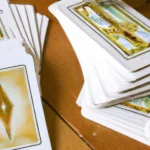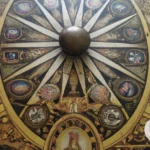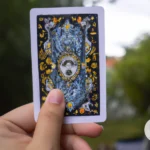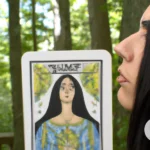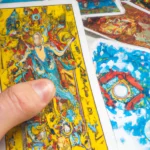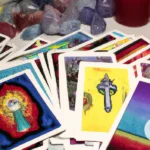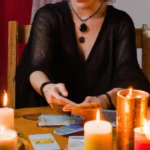As we navigate through life, we’re bound to come across moments that leave us feeling lost and uncertain. At times like these, some people turn to the Gilded Tarot deck for guidance and insight. However, for beginners, the idea of interpreting these cards can be daunting. That’s why we’ve put together a comprehensive guide to help you get started with the Gilded Tarot deck. From the history of the deck to practice exercises, this article will walk you through everything you need to know to confidently read the cards. So, grab your deck and let’s begin our journey together.
About the Gilded Tarot Deck
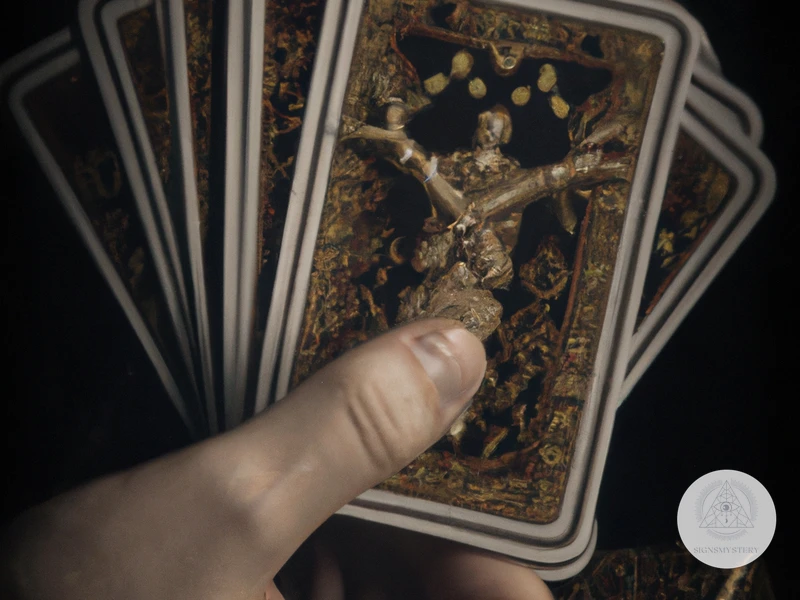
The Gilded Tarot Deck is a popular and widely-used tarot deck that combines traditional symbolism with a contemporary artistic style. This unique deck offers readers the opportunity to connect with the tarot in a new and meaningful way. If you’re interested in learning more about the Gilded Tarot Deck, you can explore its history and artwork, compare it to other decks, and discover its uses in self-reflection and growth, relationship advice, and more. Understanding the meaning behind the Gilded Tarot Deck’s iconography and symbolism can offer deep insights into your life and help you navigate the path ahead. Let’s dive into everything you need to know about this fascinating tarot deck.
History of the Deck
The Gilded Tarot Deck was created by artist Ciro Marchetti and was first published in 2004. Marchetti drew inspiration from the traditional Rider-Waite-Smith Tarot deck, but added his own unique style and flair to the cards.
The Gilded Tarot Deck features richly detailed images, with intricate gold and silver accents. Marchetti has described the deck as “a visual journey” and “a tool for self-reflection and growth” (source).
In terms of its history, the Gilded Tarot Deck is a relatively recent addition to the world of Tarot. However, it has quickly gained popularity among Tarot enthusiasts due to its stunning artwork, accessibility, and ease of use.
Compared to other Tarot decks, the Gilded Tarot Deck is relatively straightforward in terms of its iconography and symbolism (source). The images on the cards are clear and easy to interpret, making it a great option for beginners, as well as experienced Tarot readers who appreciate its aesthetic appeal.
Despite its relative simplicity, the deck still contains rich symbolism and meaning. The gold and silver accents throughout the cards represent abundance and prosperity, while the swords, wands, cups, and pentacles that feature prominently in the images correspond to the four classical elements (air, fire, water, and earth).
As with any Tarot deck, it’s important to take time to familiarize yourself with the cards and their meanings before attempting to use them for readings. We’ll delve into this more in the following sections of this article, Getting Started and Interpreting the Cards.
Before using your Gilded Tarot Deck, it’s also important to cleanse and prepare it (source). This will help ensure that the deck is clear of any negative energy and ready for use.
The Gilded Tarot Deck is a beautiful and accessible option for anyone looking to explore the world of Tarot. Whether you’re seeking guidance, self-reflection, or simply a way to appreciate the beauty of the cards, this deck is sure to be a valuable addition to your collection.
Overview of the Deck
The Gilded Tarot Deck is a visually stunning deck that will impress even experienced readers with its intricate details and beautiful artwork. The cards are designed to be easy to read and understand, making it a great option for beginners.
Here are some key features of the Gilded Tarot Deck:
- Illustrations: The card illustrations in this deck are richly detailed and brightly colored, with gold foil accents that make them shine. Each card features traditional tarot symbolism with a modern twist, making them accessible to contemporary readers.
- Iconography: The imagery in the Gilded Tarot Deck aligns with the Rider-Waite-Smith tradition, which is the most widely used tarot system. This means that the cards will be familiar to many readers, and the meanings will be easy to learn.
- Suit Names: The suits in the Gilded Tarot Deck are Swords, Cups, Wands, and Pentacles. These suit names are commonly used in tarot, and each suit has its own symbolism and associations.
- Court Cards: The court cards in this deck are King, Queen, Knight, and Page. Each court card represents a different personality type or archetype, and they can be interpreted in a variety of ways.
- Card Back: The backs of the cards in this deck feature a stylized image of a dragonfly, which is a symbol of change and transformation.
Whether you are drawn to the deck for its beautiful artwork or its user-friendly design, the Gilded Tarot Deck is a great option for beginners and experienced readers alike. To learn more about the history of the deck, check out this brief overview. If you are interested in exploring the deck’s iconography further, take a look at our article on Gilded Tarot Iconography. To choose a spread to use with the deck, see our guide on Choosing a Spread. For more in-depth information on the Major Arcana, see our article on the Major Arcana, or explore the Minor Arcana and Court Cards. If you are looking to use the Gilded Tarot Deck specifically for relationship advice, we have an article on that too: Using the Gilded Tarot Deck for Relationship Advice.
Getting Started
If you’re new to reading tarot cards, getting started can seem overwhelming. But don’t worry, with some basic information and tips, you’ll be on your way to reading the Gilded Tarot Deck with ease. In this section, we’ll cover some key steps to take as you begin exploring the world of tarot, including how to cleanse and prepare your deck, and how to choose a layout that works for you. Let’s dive in and get started!
Cleansing and Preparing Your Deck
One of the most important steps in working with any tarot deck is cleansing and preparing the deck for use. This process can help to clear any negative energy that may have accumulated during the deck’s manufacturing or shipping process, as well as set the intention for the deck’s use. Here are some methods you can use to cleanse and prepare your Gilded Tarot deck:
| Method | Description |
|---|---|
| Salt Cleansing | One of the most common methods of cleansing a tarot deck involves placing the cards in a bag or container with a handful of salt. Leave the deck overnight, and then discard the salt in the morning. |
| Moonlight Bath | Another popular method is to leave the deck out in moonlight for several hours. This can be done during a full or new moon to infuse the deck with lunar energy. |
| Crystal Cleansing | You can also place your deck on a piece of selenite, clear quartz, or amethyst overnight to draw out any unwanted energy and promote clarity. |
| Smudging | Burning sage or palo santo and wafting the smoke over the deck can also help to clear any excess or negative energy surrounding the cards. |
Once you have cleansed your deck, it is a good idea to set an intention for its use. This can be as simple as stating a positive affirmation or prayer over the deck, or lighting a candle to symbolize the start of your reading. Taking the time to perform these rituals can help to establish a deeper connection with your deck and set the tone for your readings moving forward.
Choosing a Layout
When it comes to choosing a card layout for your Gilded Tarot Deck, there are a variety of options available. It’s important to choose a layout that you feel comfortable with and that will properly address the question or situation at hand.
Here are a few popular layouts to consider:
- Three-Card Spread: As the name suggests, this simple spread involves drawing only three cards. The first card represents the past, the second the present, and the third the future or outcome. This layout is great for quick, focused readings or for gaining insight on a specific issue.
- Celtic Cross: This is a more complex spread, but it is also one of the most popular. It involves laying ten cards in a specific pattern that represents different aspects of the querent’s life or situation. The first card represents the current situation, while the others offer insight into possible influences, challenges, and outcomes. This spread is great for gaining a comprehensive overview of a situation.
- One-Card Draw: This simple layout involves drawing a single card to answer a specific question or provide guidance in a particular situation. It’s ideal for quick, straightforward readings or for situations where you need a simple answer or direction.
- Relationship Spread: This layout is specifically designed to offer insight into romantic relationships. It usually involves drawing several cards to represent the querent, their partner, the past, present, future, and potential obstacles or challenges. This spread can be helpful for gaining a deeper understanding of a romantic relationship.
- Horoscope Spread: This spread involves using the twelve signs of the zodiac to create a layout that offers guidance for each month of the year. Each sign is associated with a specific card, and the spread can provide insight into potential challenges and opportunities for growth in the coming year.
Ultimately, the key to choosing the right layout is to consider the question or situation at hand and choose a spread that will provide the most relevant and useful information. Don’t be afraid to experiment with different layouts and see which ones work best for you and your Gilded Tarot Deck.
Interpreting the Cards
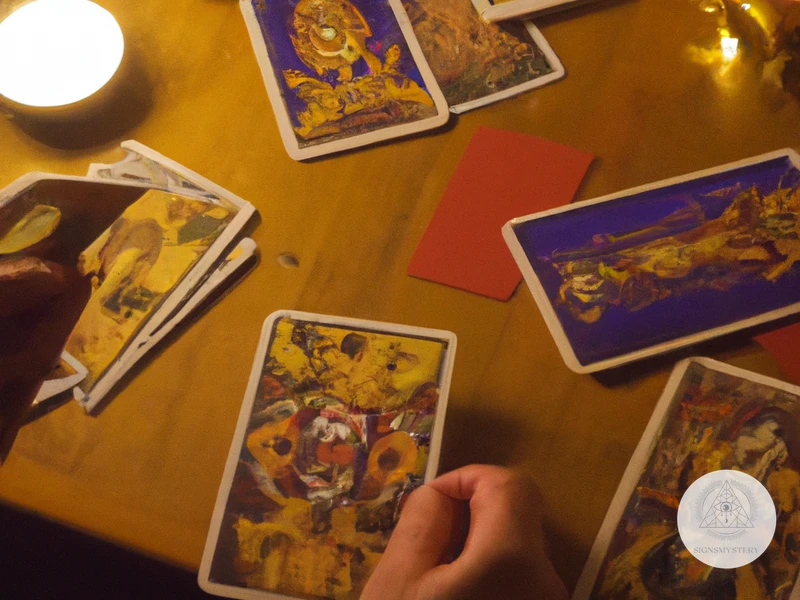
As you begin to work with the Gilded Tarot deck, one of the most exciting and potentially challenging aspects is interpreting the cards. Each card contains a wealth of symbolism and meaning, and it can be overwhelming to try to understand it all at once. However, with patience, practice, and a willingness to trust your intuition, you can start to gain a deeper understanding of the cards and their messages. In this section, we will explore the different components of the Gilded Tarot deck and provide tips for interpreting them effectively. So grab your deck, get comfortable, and let’s dive in!
The Major Arcana
The Major Arcana is a set of 22 cards in the Gilded Tarot Deck, each depicting a different archetype or symbolic figure. These cards represent significant life-changing events or spiritual transformation. Understanding the meaning of each card and how they relate to each other can provide insight into the bigger picture of a reading.
The Fool: The first card in the Major Arcana, The Fool represents new beginnings, spontaneity, and taking risks. This card encourages us to trust our instincts and take a leap of faith, even if we don’t know what lies ahead.
The Magician: The Magician is a master of manifestation and transformation. This card signifies the power of the mind to create our reality and encourages us to harness our inner potential to bring our dreams to life.
The High Priestess: The High Priestess represents intuition, wisdom, and the mysteries of the unknown. This card reminds us to look within for answers and trust our inner guidance.
The Empress: The Empress is a symbol of fertility, creativity, and abundance. This card encourages us to nurture our own growth and the growth of those around us, and to enjoy the beauty and pleasures of life.
The Emperor: The Emperor represents authority, discipline, and the power of the masculine. This card teaches us to take charge of our lives and establish order and structure, but also to avoid becoming too rigid or controlling.
The Hierophant: The Hierophant is a symbol of tradition, religion, and guidance. This card encourages us to seek wisdom from trusted sources and adhere to established values and beliefs.
The Lovers: The Lovers card represents the union of two souls and the power of love. This card encourages us to follow our hearts and make choices based on what brings us joy and fulfillment.
The Chariot: The Chariot represents willpower, determination, and victory. This card encourages us to overcome obstacles and challenges with courage and perseverance.
Strength: Strength is a symbol of inner fortitude, resilience, and the power of compassion. This card reminds us to face challenges with a gentle strength and to have faith in our own abilities.
The Hermit: The Hermit represents solitude, introspection, and the search for inner truth. This card encourages us to take time for introspection and connect with our inner selves.
The Wheel of Fortune: The Wheel of Fortune is a symbol of change, cycles, and the ups and downs of life. This card encourages us to embrace change and be open to new opportunities and experiences.
Justice: Justice is a symbol of fairness, impartiality, and balance. This card reminds us to act with integrity and make choices based on logic and reason.
The Hanged Man: The Hanged Man represents surrender, sacrifice, and the willingness to let go. This card encourages us to release our attachments and expectations and trust the unfolding of life.
Death: Death is a symbol of transformation, rebirth, and letting go of what no longer serves us. This card reminds us that change is inevitable and necessary for growth and evolution.
Temperance: Temperance represents balance, harmony, and the blending of opposites. This card encourages us to find the middle ground and integrate different aspects of our lives to create a harmonious whole.
The Devil: The Devil is a symbol of temptation, materialism, and addiction. This card reminds us to be aware of negative influences and patterns and resist the urge to indulge in destructive behaviors.
The Tower: The Tower represents upheaval, crisis, and unexpected change. This card reminds us that sometimes we need to experience a breakdown to experience breakthrough and growth.
The Star: The Star is a symbol of hope, inspiration, and renewal. This card encourages us to have faith in the universe and hold onto our dreams and aspirations.
The Moon: The Moon represents the subconscious, intuition, and the mysteries of the night. This card reminds us to trust our intuition and navigate the unknown with awareness and intuition.
The Sun: The Sun represents joy, vitality, and the light of consciousness. This card encourages us to embrace our inner child and shine our light into the world.
Judgement: Judgement is a symbol of awakening, rebirth, and redemption. This card encourages us to embrace our true selves and release any shame or guilt from the past.
The World: The World is a symbol of completion, wholeness, and mastery. This card represents attainment and fulfillment, and encourages us to celebrate our achievements and embrace our journey.
Remember that each card in the Major Arcana has a multitude of possible interpretations depending on its position in a reading and the other cards surrounding it.
The Minor Arcana
The Minor Arcana is comprised of four suits, each with its own symbolism and meaning. These suits are Cups, Swords, Wands, and Pentacles. Each suit contains 14 cards, numbered Ace through 10, as well as four Court Cards – Page, Knight, Queen, and King. The Minor Arcana is often associated with the mundane, everyday aspects of life.
The Cups Suit: The Cups are associated with emotions, relationships, and creativity. In a reading, they may represent love, happiness, or emotional growth. The Ace of Cups represents new beginnings or opportunities for emotional fulfillment. The Ten of Cups represents a happy family life or emotional harmony. The Court Cards in the Cups Suit often represent people in the querent’s life who embody emotional qualities.
The Swords Suit: The Swords are associated with challenges, conflicts, and mental clarity. In a reading, they may represent a difficult decision, a struggle, or the need to face unpleasant truths. The Ace of Swords represents a moment of mental clarity or a breakthrough in understanding. The Ten of Swords represents a painful ending or betrayal. The Court Cards in the Swords Suit often represent people who are emotionally aloof and mentally analytical.
The Wands Suit: The Wands are associated with action, creativity, and motivation. In a reading, they may represent inspiration, ambition, or the pursuit of one’s passions. The Ace of Wands represents a creative spark or a burst of inspiration. The Ten of Wands represents a heavy burden or feeling overwhelmed. The Court Cards in the Wands Suit often represent people who are energetic and enthusiastic.
The Pentacles Suit: The Pentacles are associated with material success, stability, and practicality. In a reading, they may represent financial matters, career goals, or physical health. The Ace of Pentacles represents a new job opportunity or financial windfall. The Ten of Pentacles represents financial security and generational wealth. The Court Cards in the Pentacles Suit often represent people who are grounded, practical, and reliable.
It’s important to note that the meanings of the Minor Arcana cards can be influenced by their position in a reading as well as the cards surrounding them. A skilled reader will be able to interpret the cards in relation to each other and the question being asked.
The Court Cards
In the Gilded Tarot Deck, the court cards represent different personalities or types of people that may be influencing the situation at hand. There are 16 court cards in the deck, divided into four suits: Swords, Cups, Wands, and Pentacles. Each suit has a King, Queen, Knight, and Page.
The Kings usually represent strong and established male figures. They are often associated with leadership, authority, and a strong sense of responsibility. The Kings of Swords, Cups, Wands, and Pentacles wield their respective symbols of power, and each has their own unique interpretation.
The Queens, on the other hand, often represent female figures who are nurturing and empathetic. They are typically associated with emotional stability, intuition and creativity. The Queen of Swords, Cups, Wands, and Pentacles all showcase their own distinct traits, which can be useful in interpreting them in a reading.
The Knights often indicate action or movement, and usually represent young men or women. They
Subscribe to Our Newsletter
Sign up to receive the latest news and updates.
Finally, the Pages represent youthful energy and curiosity. They are often interpreted as messengers, heralds of news, or ideas. The Pages of Swords, Cups, Wands, and Pentacles all have unique characteristics and attributes, which can provide insight into their meaning when drawn in a reading.
It’s important to remember that while the court cards may represent specific people, they can also represent archetypes, aspects of ourselves, or even situations that may arise. When interpreting court cards in a reading, it’s essential to pay attention to their position and the other cards around them.
Here is a table of the court cards in the Gilded Tarot Deck:
| Suit | King | Queen | Knight | Page |
|---|---|---|---|---|
| Swords | King of Swords | Queen of Swords | Knight of Swords | Page of Swords |
| Cups | King of Cups | Queen of Cups | Knight of Cups | Page of Cups |
| Wands | King of Wands | Queen of Wands | Knight of Wands | Page of Wands |
| Pentacles | King of Pentacles | Queen of Pentacles | Knight of Pentacles | Page of Pentacles |
Putting it All Together
Now that you have familiarized yourself with the different elements and meanings of the Gilded Tarot deck, it’s time to put it all together and start reading the cards. This can seem like a daunting task at first, but with practice, you will become more confident in your ability to interpret the cards and gain insight into the situations at hand. In this section, we will explore how to combine cards in a reading and provide practice exercises to help you hone your skills. Let’s dive in and see how we can use the cards to gain a deeper understanding of ourselves and the world around us.
Combining Cards in a Reading
When it comes to reading the Gilded Tarot deck, combining cards can give you a deeper understanding of your reading. Combining cards can help you see how different aspects of your life or situation work together to create the outcome of your reading. Here are some ways to combine cards:
| Combination | Interpretation |
|---|---|
| The Fool and The Magician | This combination points to a new beginning, where you will have the tools and skills you need to succeed. |
| The Star and The Moon | These cards suggest that you need to have hope and trust in yourself during a time of uncertainty. |
| The Hierophant and The High Priestess | This combination highlights the importance of inner wisdom and spirituality. You may need to trust your intuition to find the answers you seek. |
| The Sun and Eight of Wands | This combination suggests that you are about to embark on a journey or experience that will bring you great joy and success. |
| The Devil and Ten of Swords | These cards indicate a painful situation that you may be clinging to. You need to let go of the past and move forward. |
Remember, the meanings of the cards can change depending on the context of the reading and the combination of cards in front of you. Trust your intuition and let the cards guide you. Practice combining cards and you will become more comfortable with their meanings and how they relate to one another.
Tip: Don’t be afraid to use your own interpretations when combining cards, as the meanings can be highly personal and specific to the individual.
Practice Exercises
Now that you have a basic understanding of the Gilded Tarot deck and its cards, it’s time to practice your skills. Here are a few exercises that can help you hone your intuition and interpretative abilities:
- Draw a Daily Card: Each morning, draw a single card from your deck and spend a few minutes meditating on its meaning. Pay attention to any thoughts, feelings, or insights that come to you as you focus on the card. Consider how the card’s energy might influence your day.
- Three-Card Spread: Shuffle your deck and choose three cards at random. Place the first card on the left, the second in the middle, and the third on the right. The card on the left represents the past, the middle card signifies the present, and the card on the right predicts potential future outcomes. Consider the overarching story that these cards tell together.
- Choose a Partner: Invite a friend or family member to choose a question or situation they would like guidance on. Shuffle your deck while focusing on their question or situation. Draw a single card and use it as the basis for your interpretation. Be sure to involve your partner in the discussion and encourage them to share their thoughts and feelings about the card.
- Reverse Interpretation: Choose a few cards at random and flip them over so they are upside-down. Consider the meanings of these cards in their reversed positions. How might they differ from a traditional interpretation? What new insights can you gain from this exercise?
Remember, tarot is ultimately a tool for self-discovery and personal growth. As you practice interpreting the cards of the Gilded Tarot deck, trust your intuition and allow the cards to guide you towards deeper understanding.
Additional Tips and Resources
As you continue to delve into the fascinating world of tarot, there are several additional tips and resources that can enhance your experience and deepen your understanding. From trusting your intuition to exploring recommended reading and websites, these resources can provide valuable insights and support along your journey. Here are some suggestions to help you continue your tarot exploration with confidence and curiosity.
Trusting Your Intuition
Many people might feel a bit overwhelmed when it comes to reading tarot cards. However, the most crucial aspect of successful tarot reading is trusting your intuition. While the deck’s guidebook provides helpful insight into each card’s meaning, you should always listen to your inner voice to grasp the card’s true significance. Here are some tips on how to trust your intuition when reading the Gilded Tarot Deck:
| 1. Meditate before each reading | Before beginning any reading, take some time to quiet your mind and focus on your breathing. This will help you to clear your thoughts and be more receptive to any intuitive insights that may come to you during the reading. |
| 2. Observe the cards’ imagery and symbolism | Pay attention to how the cards’ images make you feel and what aspects of the card stand out to you the most. Use your instincts to interpret what these symbols could represent in the context of the reading. |
| 3. Trust first impressions | Don’t hesitate to trust your gut when it comes to interpreting the cards. Your first impression will often be the most accurate and insightful, as it comes from a place of unfiltered intuition. |
| 4. Practice regularly | Remember that trusting your intuition is a skill that takes practice, so don’t get discouraged if it doesn’t come naturally at first. The more you read tarot, the more you’ll develop your intuitive abilities. |
| 5. Maintain a positive attitude | Keep a positive mindset and approach each reading with an open heart and open mind. This will help you to cultivate a deep connection with your intuition and make the most of every reading. |
By trusting your intuition, you can unlock the full potential of the Gilded Tarot Deck and unlock insights and guidance that may be impossible to find through any other means. So, take these tips to heart and allow your intuition to guide you on your tarot reading journey.
Recommended Reading and Websites
If you want to continue learning about the Gilded Tarot deck and the art of reading Tarot cards, there are plenty of resources available both online and in print. Here are some recommended readings and websites to help you deepen your understanding and practice:
| Resource | Description |
|---|---|
| The Ultimate Guide to Tarot: A Beginner’s Guide to the Cards, Spreads, and Revealing the Mystery of the Tarot by Liz Dean | This book is a great resource for beginners, providing an easy-to-understand overview of Tarot history, symbolism, and how to read the cards. It includes plenty of helpful illustrations and sample readings. |
| Biddy Tarot | This website offers a wealth of Tarot resources, including free printable Tarot card meanings, tips for beginners, and online courses for more advanced learners. They also have a Tarot community where you can connect with other enthusiasts and Tarot readers. |
| Tarot for Beginners: A Guide to Psychic Tarot Reading, Real Tarot Card Meanings, and Simple Tarot Spreads by Lisa Chamberlain | This book covers everything from the basics of Tarot reading to more advanced topics like reversed card meanings and different Tarot spreads. It also includes sample readings and exercises to help you practice and improve your skills. |
| Tarot.com | This website offers a variety of Tarot readings, as well as resources for those who want to learn more about Tarot. They also have a blog with helpful articles on Tarot history, symbolism, and how to read the cards. |
Remember, learning Tarot is a journey, and it takes time and practice to develop your skills. Don’t be afraid to experiment and try different methods to find what works best for you. Above all, trust your intuition and have fun with it!
Conclusion
After reading this beginner’s guide to the Gilded Tarot deck, we hope you feel more confident in your ability to read and interpret these powerful cards. Whether you are a curious beginner or have been practicing for years, the Gilded Tarot deck can offer insight and guidance in many areas of your life.
Remember to approach each reading with an open mind and a willingness to learn. Trust your intuition and allow the cards to speak to you in their own unique way. Don’t be afraid to experiment with different layouts and interpreting techniques until you find what works best for you.
It’s also important to remember that tarot is not a substitute for professional advice or therapy. If you are struggling with serious issues, seek help from a qualified professional.
Lastly, continue to learn and grow in your tarot practice by exploring recommended reading and websites. There is always more to learn and discover about this ancient art.
Overall, the Gilded Tarot deck can be an incredible tool for self-discovery and personal growth. We hope this guide has helped you on your journey towards a deeper understanding of this fascinating practice.
Frequently Asked Questions
How do I choose a Gilded Tarot Deck?
Choosing a Gilded Tarot Deck comes down to personal preference. Look for a deck with artwork that resonates with you and feel comfortable holding in your hands.
Do I need to cleanse my Gilded Tarot Deck?
Yes, it is recommended to cleanse your Gilded Tarot Deck before use. You can do this by smudging with sage or palo santo, placing in the moonlight or sunlight, or using a crystal to clear the energy.
How do I shuffle my Gilded Tarot Deck?
There are several ways to shuffle your Gilded Tarot Deck, including overhand shuffling, riffle shuffling, and cutting the deck. Experiment with different methods to find what feels most comfortable for you.
What is a tarot layout?
A tarot layout is a specific pattern in which the cards are arranged for a reading. Some popular layouts include the Celtic Cross, Three-Card Spread, and One-Card Draw.
How do I interpret the Major Arcana?
The Major Arcana are the 22 cards in the Tarot Deck that represent major life events or spiritual themes. Interpretation of these cards can vary, but they often represent important lessons or turning points in one’s life.
What do the Minor Arcana represent?
The Minor Arcana are the 56 cards in the Tarot Deck that represent everyday events and experiences. They are divided into four suits, each with its own meaning and symbolism.
What are Court Cards?
The Court Cards are a subset of the Minor Arcana that represent people and personalities. They are often associated with specific Zodiac signs and can represent aspects of one’s self or others in a reading.
Can the Gilded Tarot Deck predict the future?
The Gilded Tarot Deck is not necessarily meant to predict the future, but rather to provide guidance and insight based on the present moment and the energies surrounding a situation or decision.
How do I combine cards in a reading?
Combining cards in a reading involves finding the connections and relationships between the cards drawn. Look for patterns, symbols, and themes that arise, and use intuition to interpret their meaning within the context of the reading.
How do I trust my intuition while reading the Gilded Tarot Deck?
Trusting your intuition comes with practice and experience. Start by paying attention to your initial impressions and feelings when drawing and interpreting cards. As you continue to use the Gilded Tarot Deck, you will become more confident in your intuition and ability to read the cards.



